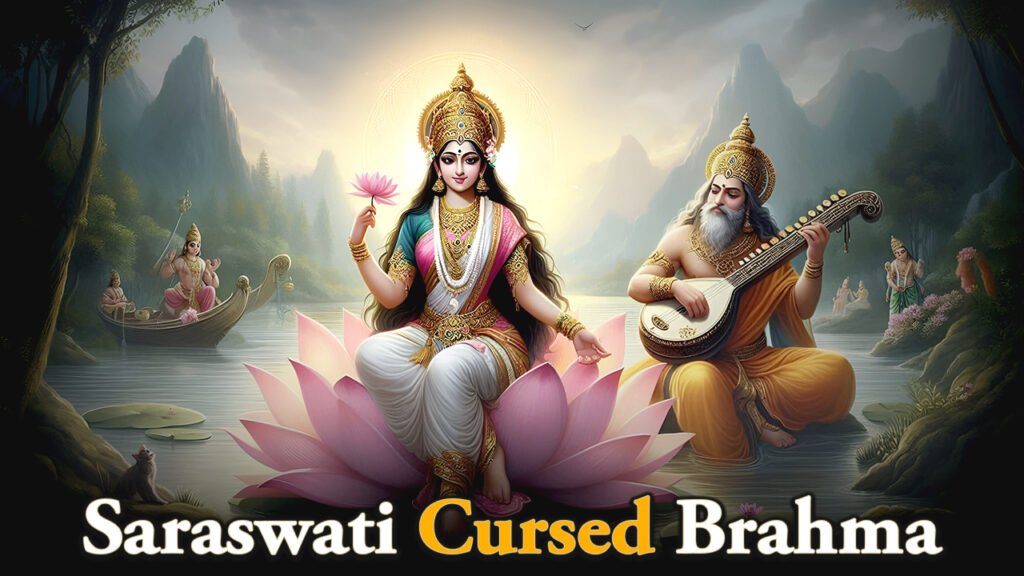Introduction to Saraswati Cursed Brahma
Hindu mythology is rich with fascinating tales that often carry deep moral and philosophical implications. One such intriguing story is that of Goddess Saraswati Cursed Brahma. This ancient tale has been passed down through generations, captivating the minds of believers and scholars alike. In this article, we’ll delve into the depths of this mythological narrative, exploring its origins, significance, and the lessons it imparts.
The Origin of Brahma and Saraswati
To understand the story, we must first familiarize ourselves with its main characters. Brahma, one of the principal deities in Hinduism, is known as the creator of the universe. Saraswati, on the other hand, is the goddess of knowledge, wisdom, music, and arts. Interestingly, in some versions of Hindu mythology, Saraswati Cursed Brahma daughter, while in others, she is his wife.
Sacred Role of Brahma in Hinduism
Brahma holds a significant position in the Hindu trinity, alongside Vishnu (the preserver) and Shiva (the destroyer). His primary role is that of creation, bringing forth all life and the universe itself. Despite this crucial function, Brahma is not as widely worshipped as the other two deities of the trinity, and the tale of Saraswati’s curse offers an explanation for this peculiar phenomenon.
Goddess Saraswati: The Embodiment of Knowledge and Wisdom
Saraswati, revered as the goddess of knowledge and wisdom, plays a vital role in Hindu culture. She is often depicted holding a veena (a musical instrument) and a book, symbolizing her association with learning, arts, and creativity. Her wisdom and purity are central to the story of her encounter with Brahma.
The Fateful Encounter
The tale begins with Brahma’s creation of the universe. As he brought forth various beings, he also created Saraswati, who was so beautiful that Brahma became instantly enamored with her. This infatuation led to a series of events that would ultimately result in Saraswati Cursed Brahma.
The Four Heads of Brahma
Creation of the Fifth Head
In his desire to constantly gaze upon Saraswati’s beauty, Brahma created four heads for himself, each facing a different direction. However, Saraswati, uncomfortable with this constant attention, tried to escape his gaze. In response, Brahma created a fifth head on top, ensuring that he could always see her.
The Consequences of Desire
This act of creating an additional head to satisfy his desire marks the turning point in the story. It demonstrates how even a supreme being like Brahma could fall prey to lust and attachment, leading to actions that would have severe consequences.
Saraswati’s Curse
The Nature of the Curse
Disturbed by Brahma’s inappropriate behavior and unwanted advances, Saraswati decided to curse him. The nature of this curse varied in different versions of the story, but the most common account states that Saraswati cursed Brahma, declaring that he would not be worshipped by people on Earth.
The Reasoning Behind the Curse
Saraswati’s decision to curse Brahma was not merely an act of anger but a response to his loss of control and wisdom. As the embodiment of knowledge, Saraswati found it unacceptable that the creator himself would succumb to base desires and act in a manner unbefitting his status.
The Aftermath of the Curse
Brahma’s Diminished Worship
As a result of Saraswati’s curse, Brahma’s worship significantly diminished on Earth. This explains why, despite being one of the principal deities of the Hindu trinity, Brahma has very few temples dedicated to him compared to Vishnu and Shiva.
Saraswati’s Departure
In some versions of the tale, following the curse, Saraswati left Brahma and went to live on Earth, spreading knowledge and wisdom among humans. This narrative adds another layer to Saraswati’s role as the goddess of learning and her connection to human intellectual pursuits.
Lessons from the Tale
The Importance of Self-Control
One of the primary lessons from this mythological story is the importance of self-control and the dangers of unchecked desire. Even Brahma, the creator, faced consequences for allowing his desires to overpower his wisdom and judgment.
The Power of Knowledge and Wisdom
The tale also emphasizes the supreme importance of knowledge and wisdom, personified by Saraswati. Her ability to curse even the creator of the universe underscores the power of knowledge over mere creation.
Different Versions of the Story
Like many mythological tales, the story of Saraswati cursing Brahma has multiple versions. In some accounts, it was Lord Shiva who cut off Brahma’s fifth head for his inappropriate behavior. These variations add richness to the narrative and often reflect regional or cultural differences in the interpretation of Hindu mythology.
Symbolism in the Tale
The story is ripe with symbolism. Brahma’s multiple heads can be seen as representing the all-pervading nature of the creator, while Saraswati’s actions symbolize the triumph of wisdom over unbridled passion. The curse itself can be interpreted as a reminder of the consequences of losing one’s moral compass.
Modern Interpretations
In contemporary times, this ancient tale has been subject to various interpretations. Some view it as a metaphor for the human condition, where intellect (Saraswati) must check and balance raw creative energy (Brahma). Others see it as an early mythological account addressing issues of consent and respect.
For interesting astrology-related videos, subscribe to us on YouTube
The Curse’s Impact on Hindu Mythology
The curse of Saraswati on Brahma has had a lasting impact on Hindu mythology and religious practices. It not only explains the relative lack of Brahma worship but also reinforces the importance of Saraswati as a deity. The tale has influenced countless other stories and religious traditions within Hinduism.
Read Also: Dreams and its astrological significance
Conclusion
The story of Goddess Saraswati cursing Lord Brahma is more than just a mythological tale. It’s a complex narrative that touches upon themes of creation, desire, wisdom, and consequences. This ancient story continues to fascinate and inspire, offering valuable lessons about the power of knowledge and the importance of ethical behavior, even for the mightiest of beings. As we reflect on this tale, we’re reminded of the depth and richness of Hindu mythology and its enduring relevance in our lives today.
FAQs
- Why are there so few temples dedicated to Brahma?The scarcity of Brahma temples is often attributed to Saraswati Cursed Brahma curse, which decreed that Brahma would not be widely worshipped on Earth.
- Is Saraswati Brahma’s wife or daughter?In different versions of Hindu mythology, Saraswati Cursed Brahma is portrayed either as Brahma’s wife or his daughter, reflecting the complex nature of divine relationships in Hindu tradition.
- What does Saraswati’s curse teach us?The curse emphasizes the importance of self-control, the power of wisdom over desire, and the consequences of inappropriate behavior, even for divine beings.
- Are there any famous temples dedicated to Brahma?Yes, the most renowned Brahma temple is located in Pushkar, Rajasthan, India. It’s one of the few temples where Brahma is worshipped as the main deity.
- How does this story reflect on the status of women in Hindu mythology?The tale showcases the power and respect accorded to female deities in Hindu mythology, with Saraswati Cursed Brahma wisdom and moral standing superseding even the creator’s authority.

